Living in Europe does have its advantages when it comes to teaching a child about medieval times. If Adrian were any older, he'd probably be delighted by the jousting tournaments Germany offers (yes, they are back!), the history found in various museums and be surprised to hear that the plague completely wiped the human race from the area we currently live in. For now, he simply enjoys the festival with the "costumes" and the beautiful castles.
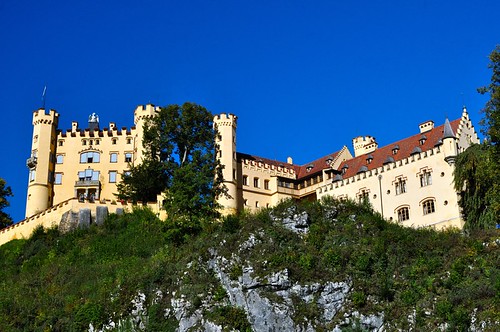
Hohenschwangau Castle, Germany - A Medieval Castle we visited last fall

Building a wood castle for our knight
Most families have wooden blocks of some kind. We were gifted these beautiful natural wood blocks made by Melissa & Doug one or two years ago. They do not get that much playtime but if I bring them out along with ideas, then they do. The task that day was to build a castle for a knight and a "cave" for a dragon. Adrian quite enjoyed having our Fisher-Price plastic knight visit the wooden castle after.
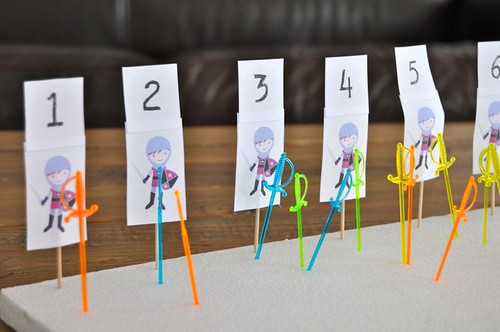
Counting & Poking Swords
Jolanthe, at Homeschool Creations, makes beautiful FREE preschool packs I use once in a while. I don't like worksheets per se but I'll use bits here and there. The numbers and knight cards you see above were part of her Knights package. I taped the numbers and knights together and taped them to a toothpick I then inserted into a styrofoam board. I also put plastic sword toothpicks into a bowl and let Adrian poke them in a row in front of each number. They represented, I said, the quantity of swords the knights needed in their castle.
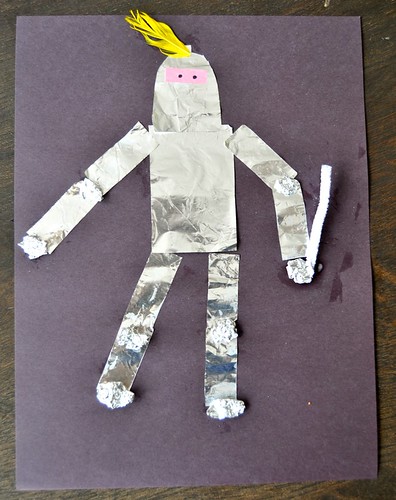
A knight in shining armor - Tin foil knight craft
This picture does not make it justice but it truly was a nice craft to make for a preschooler. I personally pre-cut the shapes since foil is so easily torn but I let Adrian crumple the foil for the feet, hands, knees and elbows. He's also the one who glued all the parts in place, including the sword (pipe cleaner), feather and eyes (pink construction paper with two black dots). Wanna make one as well? Check out the template at Busy Bee Crafts! That is where we got ours and where the idea for the craft came from. By the way, Busy Bee Crafts has a few more medieval crafts your kids might enjoy. We thought about building our own catapult for the activity listed next but in the end, ran out of time and used the one we already had...
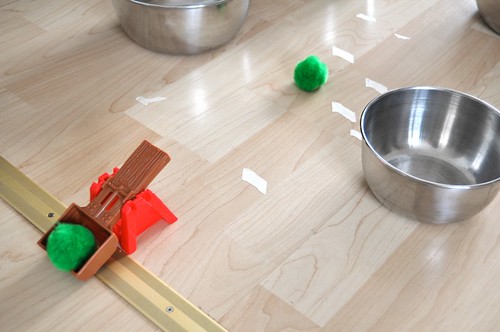
Catapult testing - how far, how high, and adjusting to reach targets
I pretty much knew this would be well loved. I did not want it to be simple catapulting though. I did want to involve more physics and understanding of how catapults were used back in the Middles Ages. Our first test involved calculating the distance our pompoms were going and how to make it go far and how to keep it close (see masking tape pieced on the grounds?). Then we tried to make it go high and then tried to keep it low. Finally, I asked Adrian if he could figure out how to hit our targets (the mixing bowls on the grounds). It didn't take him long to figure out the catapult should be aligned with the targets to be effective! Now we own a catapult thanks to a Fisher-Price Little People Play 'N Go Castle set but I initially intended to build a catapult with Adrian following the instructions given on Busy Bee Crafts. See link above.
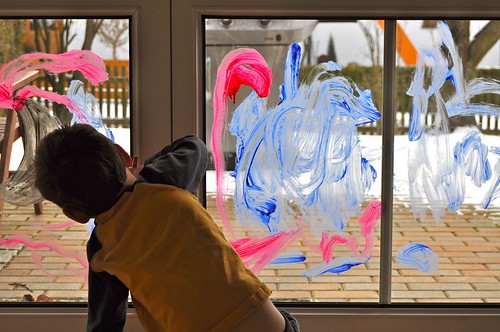
Making a "medieval" stained glass window
Stained glass became quite popular during the Middle Ages and I thought it would be kind of fun to do a "kid" version of stained glass. That usually means using "contact" paper or waxed paper but we had just done that for Valentine's Day so I decided to let Adrian paint the windows. Yep. I wasn't sure I wasn't gonna regret my decision but I had read that writing on a vertical surface might help his pencil grip so the incentive was there. Turns out, Adrian LOVED painting the windows. He wasn't sure he should at first and hesitated knowing I'd normally say this wasn't allowed. I made sure I explained this was a one-time thing. We used liquid washable tempera paint mixed with dish soap. Once it was dried, I washed it off with water and had no trouble getting it off at all. I encouraged Adrian to draw but he really just wanted to paint and spread colors all over.
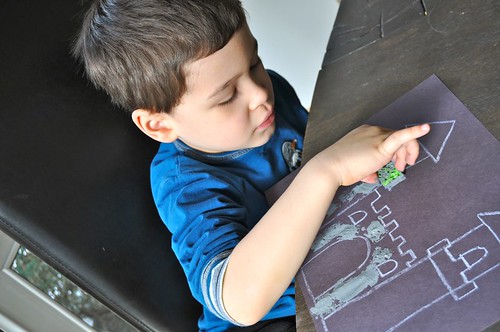
Sponge-printed castle - Art & Fine Motor
Fine motor skills and art? Absolutely. Other than a good pencil grasp, there is also the tiny sponges that can get involved! Today I cut a tiny sponge from a much bigger kitchen sponge for Adrian to use on this white crayon castle (pre-drawn by...me! No laughing!). The idea was to make "brick prints". Of course, with a preschooler, bricks might not look so much like bricks because they like to dip their sponges into A LOT of paint but if you can convince your child to dip lightly and to print often instead of dipping every time, you may have beautiful bricks on your castle, especially if they are spaced instead of all stacked on top of one another. I tend to emphasize the process over the product with my kids so to me, Adrian's castle was great. I love that he finished it (not a small task with a tiny sponge and that he printed instead of smeared the paper like he could have). The idea for this castle was adapted from Deep Space Sparkle who did the project with older kids and included more steps.
Thanks for the ideas! We're studying Knights this next week. I'm sure you'll notice some similar activities, attributed to you of course. :)
ReplyDeleteGreat! I'm glad you found some inspiration. I had a hard time finding ideas online for this unit. There were several for games but not too many educational ones I liked in Adrian's level. Can't wait to see yours!
Delete